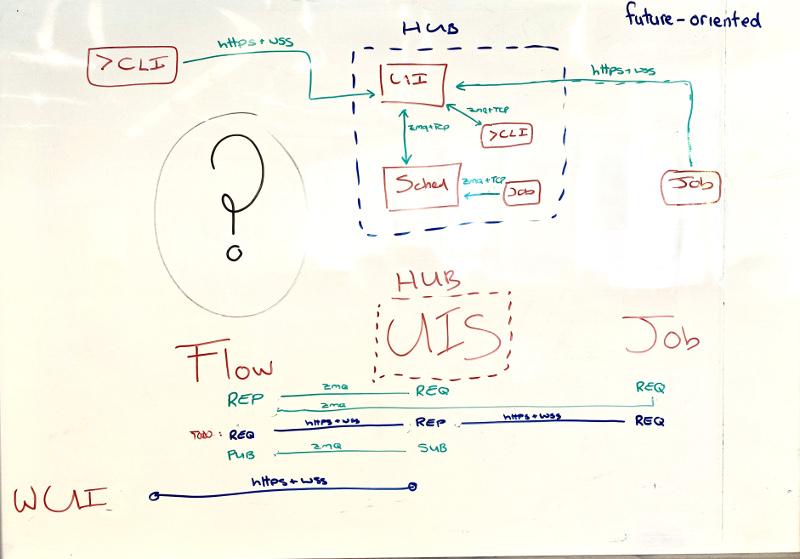cylc-admin
Feb 2020 Cylc Workshop Notes
Hilary Oliver
Points noted mostly in the order they arose in discussions. I’ll attempt to distil a summary report from this later
Monday
- (DM) cross-user functionality is essential for 8.0
- can J-Hub do it out of the box?
- expose via the UI?
-
(DM) apparently not all J-Hub internal communication is secure yet. Need to investigate and check latest release
-
OS: selection sharing between views needed in 8.0 if possible (e.g. select tasks in treeview, see same tasks in graph view)
-
UI Design TODO: how to display the status of mutations that are in progress? Need to be able to minimize and expand.
- TW: table is still needed for an “information-dense” view, column-sortable
- filter by job exit code (see next point)
- TW: discussion on capture and use of job exit codes
- non-zero values are supposed to indicate failure but some applications do use them to convey other info
- triggering off of exit codes would be easier than translating to custom
messages in the job script:
foo:127 => bar - not ideal in multi-command user-written job scripts (did the exit code come from the expected command? - makes more sense for single “job commands” but we could support this and warn users of potential pitfalls.)
- we could allow “job fail but task succeed” so the workflow can carry on (the automatic analogue of manual reset to succeeded)
- (message triggers will be displayed in the UI - design TODO)
- Cylc Review: currently deleted from cylc-flow, but needed for 8.0.
Contingency, easiest-but-least desirable first:
- restore as-is with Python 2.7, and as a separate service
- port to Python 3, still a separate service
- full integration with UI views (post 8.0)
- Hub remote spawning of UI Servers
- (JR) BOM may have a problem with this (in production area)
- can we manually start UI Servers, and have them connect to the hub (this would require authenticating with the hub as the user and somehow transferring the right auth info to the UIS to make them connect - difficult?)
- (HO) was told J-Hub approved by the architecture team; single-point of access and site ident integration was insisted on by BOM and requires this kind of architecture (with distributed run-as-the-user components on the back end)
- (DM) let’s not go down this route until we know if it really is a problem
- JR to find out more and report back
- (OS) load balancing of multiple UIS (many users) on multiple VMs: should be able to take the existing psutils infrastructure from cylc-flow (for load balancing schedulers) and integrate it into our spawners
- a UIS should time out and die if no one is looking at it (and spawned again when needed) even if not using much resource at idle - opportunity for upgrading the release
- (JR) BOM may have a problem with this (in production area)
- CLI via UIS (or rather, via hub proxy)
- needed for CLI to other-user workflows, or from account with access to the workflows filesystem access
- also possible solution to remote job sites with only HTTPS ports open? (TW)
- but need to figure out how authentication would work?
- configurable choice or fall-back? (CLI direct to Sched, then via UIS)
- OS: we could abstract out the protocol bit from CLI (“just a send/receive interface, with authentication) to allow swap out ZMQ for something else (but note plain https can’t do subscriptions); (ZMQ is TCP with Curve auth).
- HO: CLI to hub solves the UIS persistence problem as hub will spawn one
cylc scanis an edge case, only needs UIS to see other users
-
(BK) note that our wss header for authentication is not set yet, anyone can connect if they can see the endpoint
- new
cylc monitordemo:- closely replicates the web UI treeview
- needs state totals at top and responsive filtering (this should make it as useful as the old monitor for displaying failures quickly, while remaining vastly more useful in other ways).
- will add mutations
- (can keep old monitor as well if really necessary - it’s pretty trivial)
Data Provision
- Event driven, incremental update, throughout the system, is almost done.
- (the two new PRs are implemented via a different subscription to avoid breaking the current UI, until we mod the data store to the new way … has to test with Graphiql for now)
-
DS had to integrate GraphQL with ZMQ ourselves (no lib solution yet)
-
n=N window: Sched keeps active tasks (n=1 window), but UIS could cache historical data back to n=3 say, to avoid going to disk for that
-
GraphQL allows fine-grained authorization (on individual fields) identical for CLI and wUI
-
UIS detects running schedulers with imported
cylc scancode (which scans the filesystem) - what data is kept in each data store?
- longer term the scheduler data store should become the scheduler state, so we should keep the full n=1 window, for all available data, there
- currently the UIS mirrors the full scheduler data store, but each subscription topic is incrementally updated as content changes
- OS: the plan was to have the UIS data store only populated according to
the UI subscriptions. We can still look at this as next steps, but:
- data stores seem to be much smaller than expected (1MB for complex suites?) so it might not be an issue to keep all the data there
- however, the new UI gscan sidebar shows the problem in principle: at UI start-up gscan’s subscription will cause the UIS to immediately load all the data for all the workflows it can see - seems unnecessary
- but (DS) subset at the UIS would require parsing the incoming subscription to figure out what new subscription, if any, needs to be subscribed to at the schedulers … which seems difficult. Nested queries are particularly difficult to analyse in this way, but (OS) we are going fully flat anyhow. Nested queries are particularly difficult to analyse in this way, but (OS) we intend to go fully flat anyhow
- what about data outside of the active window? UIS can ask the sched first; if nothing returned go to disk instead?
- OS: showing the future graph will be more difficult in the future; may be able to go back to n=N, but forward only to n=1. At the moment we can go forward using the graph config, if all possible future paths are graphed, but future dynamic sub-graphs cannot be known in advance (display as an empty box that gets populated once known?)
Tuesday
-
DM: Suite UUID? (messages from orphaned tasks rejected as UUID differs from that in the contact file). Suite “run number” is probably simpler than UUID.
-
Agreed how to represent retries & other xtriggers in the UI - OS to update the Issue pages. Most xtriggers like nodes in the graph view, but queued should be shown as a badge like held (and only if the task is actively held back in the queue; queued takes precedence).
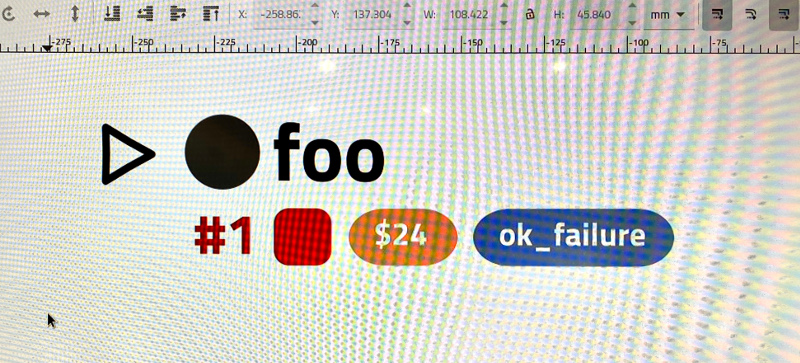
-
selection sharing, i.e. link views in the UI. Could link focus of two views, e.g. by mouse drag, then subsequently keep linked, or not? If linked, should be two-way.
-
job icon theming is in already - have standard, greyscale, colour blind, but no way to set prefs yet. Theming should be straightforward, just needs to be done.
- User Preferences:
- TODO: can the Hub DB or our own Hub Service + DB store user preferences?
- authenticated users don’t necessarily have an account on the back end, so we should store prefs at the Hub (slightly more general than browser cookies).
- Prefs export/input functionality for easy switch to other hubs?
- named profiles might be needed, to associate different prefs with different
UI Servers (e.g. ops vs test) - after 8.0
- or just do this via user@hub box color?
- Graph View
- Cytoscape not good for our needs (canvas vs svg, display engine)
- Dagre layout engine is needed
- but writing our own display engine not hard (OS had a POC ready in one day)
- BK debugging demo:
- front end: browser dev tools, including Vue extension
- back end: PyCharm, easy to connect to subprocesses
-
DS on the data stores: concerned about how to group changes once the Sched main loop is gone. The main loop is a convenient way to ensure that changes to various data elements are grouped in a self-consistent whole before pushing to the subscription.
- OS: need CylcCon page on the website to show that we are an active project. HO to do.
Spawn-on-Demand (HO)
- Tantalisingly close to do-able within the current “task pool” framework, for Cylc 8?
- Needs n-edge window for the UI to be effective
- but we need to deal with this anyway
- SoS has some serious problems, we’ve just learned to live with them
cylc monitorneeds to go via UIS and direct to WFS (Workflow Scheduler). Direct will see on n=0 (active tasks)- Need an “n-max” setting that will populate entire cycle points in the UI
- Can treat succeeded and failed states equally (in SoD, remove them
immediately) - but we can choose (optionally?) to keep them until dismissed,
at least until the UI has better ways to alert users to failed tasks
- a list of failed tasks? Have to be able to retrigger from the alerting list
- Tracking conditional prerequisites is tricky, requires in-memory or perhaps disk caching?
- (JR) if needed, use existing disk caching or in-memory DB (redis) systems for this
- Can’t let suite stalls result in shutdown because no active tasks left in the pool!
- watch out for failed tasks that are not a graph leaf node
- so: don’t remove tasks whose outputs were not handled? - i.e. they did not spawn (conditionals are difficult again?)
- Need a battery of examples to clearly demonstrate expected behaviours (HO to start this)
-
(TW): consider two tasks waiting on different xtriggers; if one gets satisfied it means the other never will and needs to be removed from the suite. It seems we’ll still need suicide triggers to achieve that removal? (HO to consider and update SoD proposal).
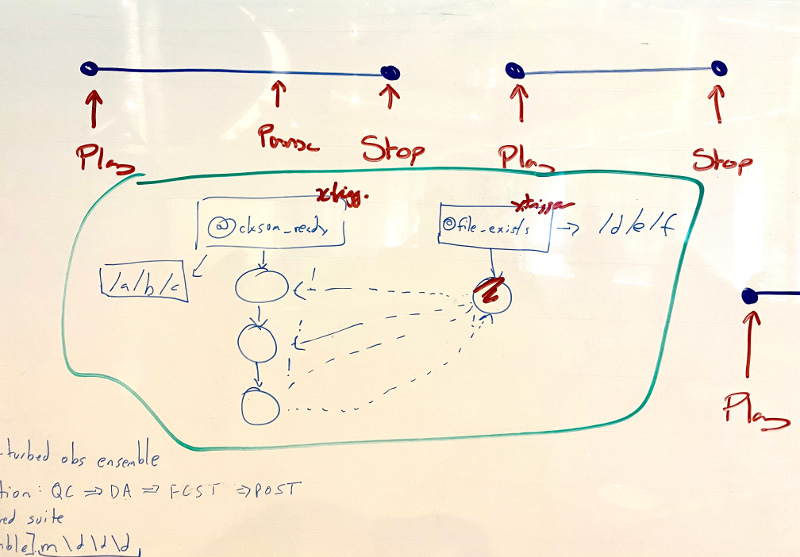
- contingency plan if we can’t pull off SoD:
- revert to the old SoS model: need to show task pool and ghost nodes (like the cylc 7 graph view does)
- (OS) “task pool” no longer a good term? (HO not so sure… now it’s just a pool of active tasks.
- (OS) TaskProxy should be renamed Job? (the Proxy class has been gutted, no longer doing retry logic etc.)
- Can we unify outputs and prerequisites/triggers?
- Reflow could be super-useful (just trigger the top task of the tree to re-run)
- HO: need a “flow ID” passed along via the on-demand spawning mechanism
- hard to support partial triggering by tasks from the original flow (have to search arbitrarily far back to determine whether a task can be fully satisfied within the reflow or not?)
- initially may have to disallow reflow (retriggering just runs the one task) or require manual triggering of tasks with off-flow prerequisites
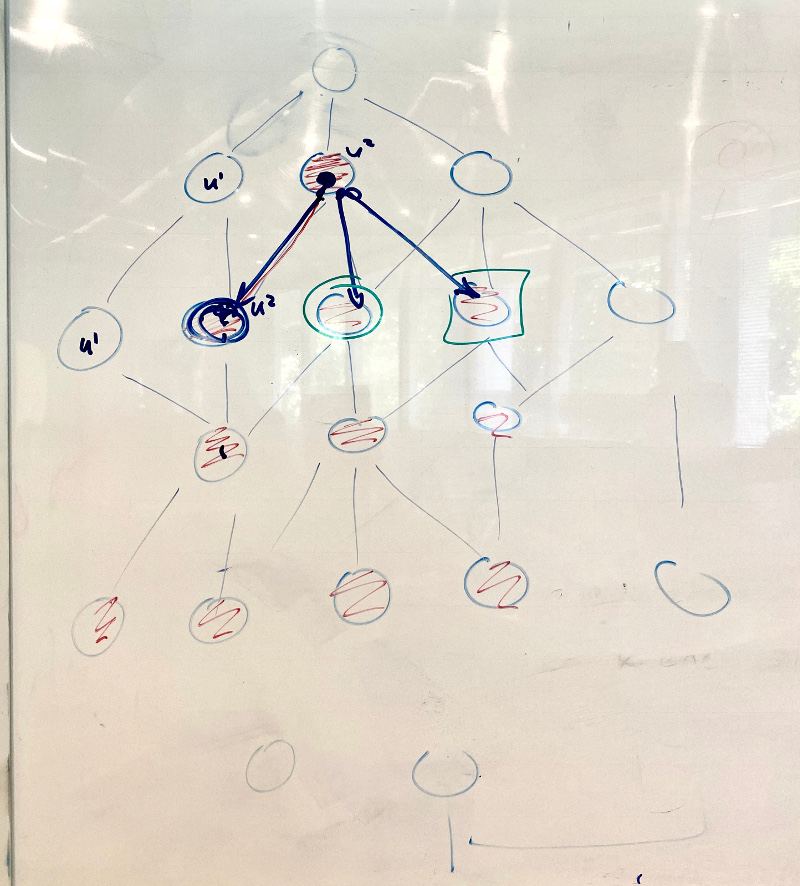
- (MH) interesting idea on representing tasks as edges that connect task event nodes.
- looks somewhat promising but difficult to see how to handle multiple outputs and conditional triggers. Investigate further for Cylc 9?
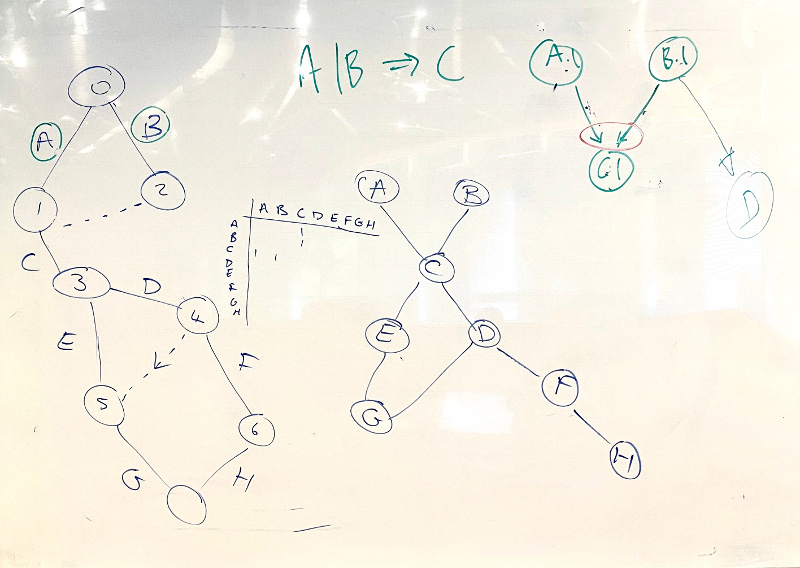
Asyncio and coroutines (OS)
- we should make an event-driven system where coroutines process queued task events
- e.g. job submission done by a coroutine that processes job submission events
- queues become the state of the workflow (which need to be cleared for shutdown)
- better xtriggers:
- “push” xtriggers, e.g. for suite-state (await socket, yield result)
Wednesday
(Config item discussion extended to Thursday morning - all noted here though)
New Platforms Config:
- proposal generally agreed
- (JR) should help with BOM two-cluster setup
[foo/d/d|bar/d/d]- need to support comma-sep list for consistency (but can’t prevent OR’d regex obviously)
File Installation (rose suite-run migration):
- this is next up for implementation
- what gets installed needs to be configurable, or else copy all
-
need a shell interface as well as
psutilsfor “load” on platforms, e.g. to query number of pending PBS jobs -
TW generally agrees with the
rose suite-runway of working with suites, no need to continue supporting the old way - Ideally file installation and FS setup needs to be handled as a “pre-graph” task, for visibility (otherwise pre-detach ties up the terminal, and post-detach is hard to show users what’s happening).
New “run1, run2” structure:
- new run for any “cold start”, for safety and provenance
- “in-place warm start” use case requires option to copy or mv data dirs from prev run
- might want to compress logs in old runs
- NN symlink to latest run
- NEW: first under cylc-run dir should be the suite source name (with
location link inside it) - the source is a template for multiple suites,
which can each have multiple runs
- this is just to impose a clearer convention - it uses the existing cylc reg hierarchy capability. Otherwise nothing has changed.
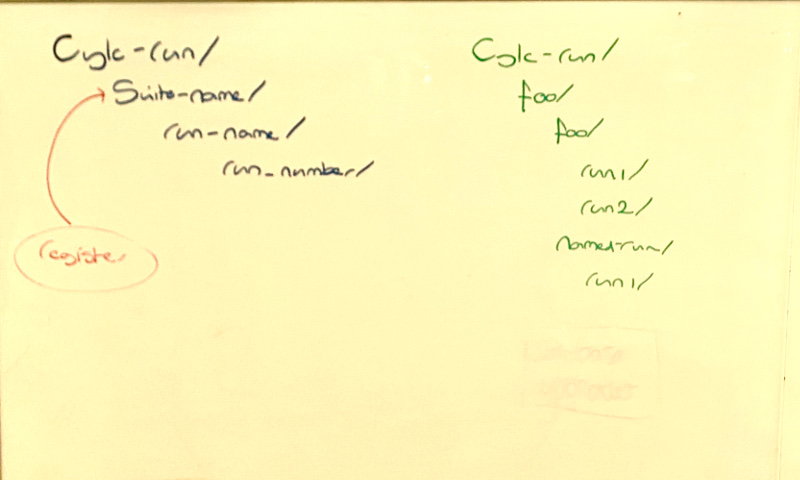
Run (and install) command semantics
- need a separate command for install, avoid confusing compound commands
- (however, a “cold start” should always install)
- NEW (actually, discussed in Exeter, but we forgot!) use git to automatically manage the installed dir - detect and describe changes, checkout to install, etc.
--setJinja2 command line parameters should be stored in the install dir in a user-readable config file (they are in the DB for restart use, but not really visible to users)
NEW run command names (intuitive, good UI icons):
cylc installcylc play(cold start, warm start, restart-from-state-snapshot, un-hold)cylc stop(shutdown, pause)- deprecate old commands via invisible alias? (for scripted use of them)
- Rose: drop
rose suite-runand print a helpful error message if users invoke it.
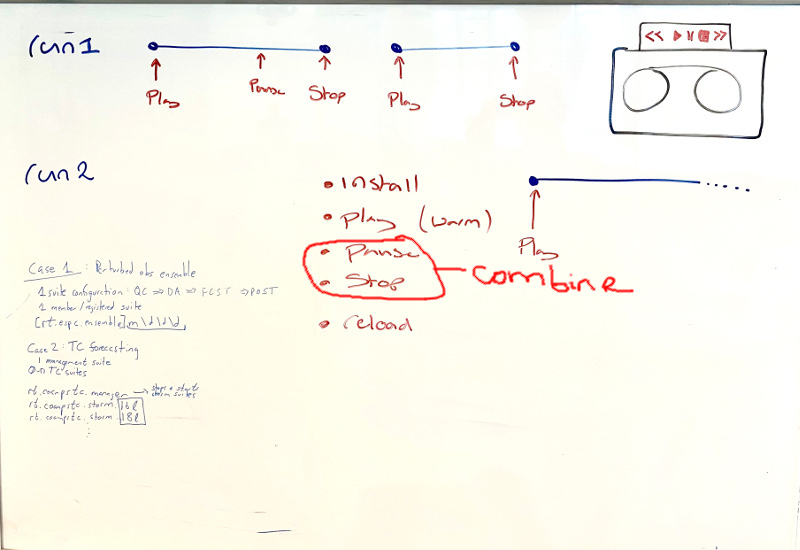
Config File names agreed:
flow.cylcglobal.cylc- (and
flow-tests.rc?)
Config Item changes:
-
(DM) let’s not bother deprecating global config changes
-
need ability to configure site global conf location by
CYLC_SITE_CONF_PATHfor cylc installations with no/etcaccess. Default to/etcthough. -
agreed on the conf dir hierarchy in the proposal (need version sub-dirs)
-
agreed on the “alternative” scheduler platform config proposal
-
task event batch interval(for event mail batching) -
get rid of
cylcsection entirely -
platforms, NOTjob platforms - move all
cylc pointitems to the scheduling section- future: need clearer names of initial vs start, and stop vs final cycle points? (start and stop may be “inside” the graph)
- UTC mode: separate config needed for cycle point UTC mode from log timestamps
-
need
stop after cycle point(havehold after...) -
expected task failures- leave as-is (ref tests only) -
abort if any task fails- deprecate this config and make it a command line option scheduler environment- remove it!- (otherwise for consistent behaviour on local and remote hosts we have to export these vars in subprocess before command invocations, … but this will get muddied once we allow async functions as well as subprocess (e.g. event handlers)
- TW: we need to restore non-local dummy mode to allow investigation
of the effect of resource changes on a workflow (you can tell PBS it has more
resources than it really has, then request more but just submit a dummy task…)
- we have removed this already from Cylc 8 because dummy-local is much simpler to implement as just a “dummy platform”.
simulation: disable suite event handlers- should be phrased positively
[scheduling]use suite event handlers = True?- (hmm, can’t recall what we decided on this)
-
[editors]- discourage use and make it default to$EDITORand$GEDITOR(and toviif those vars aren’t set). -
agreed to use None as config default instead of empty string, to allow us to distinguish “set to nothing” from “not set”
-
disable interactive command prompts- remove command prompts - change
batch systemtojob runner- “batch system” is a poor name for background jobs
- and for future cloud-y and otherwise non-HPC ways of running jobs
-
batch system handlers should be plugins (we put an issue up for this)
-
batch system command template- put an issue up to consider removing this (inconsistent as no poll and kill templates here) but leave for now as it is used in the test battery about 6 times. -
task event handler retry delaysis not needed as a platform setting (remove it) -
remove
scp commandconfig, and thescp-copyutil command -
test battery config section can be removed as now in
global-tests.cylc(but need to check this) -
extra log files- remove this and just provide access to all files found in the job log dir (DS to remove from data schemas too) -
(forget other suggested item name changes, not worth it)
- TODO:
- get current config-affecting PRs merged, then
- update the config proposal via PR, then
- OS to document configs with his auto-doc changes
Back-end Authentication (MH)
- CurveZMQ
- currently the private key gets copied to job hosts
- we should generate key pairs at both ends and transfer the public ones both ways
- test for shared FS
- we should generate key pairs at both ends and transfer the public ones both ways
- uses existing ZMQ API to generate the keys
- client times out if access denied (unfortunately that good from a security perspective)
- we could report “connection timed out, this could be due to …”
- WFS -> ssh -> job leaves a small window for “man in the middle” attacks
- solved pretty well by not authorizing jobs to send anything but
cylc messageback (“platform authorization”)
- solved pretty well by not authorizing jobs to send anything but
- “ssh messaging” needs to be restored on master
- do it via ssh tunnel with ZMQ
- (TW): need CLI-UIS for remote platforms
- can we use a Hub API to generate tokens and use those to authenticate?
- (JR): all messages might need timestamps
- (I think we decided against this? … because CurveZMQ protects against replay attacks?)
Authorization
- need site and user config
- user can ramp up authorization levels as far as the site allows
- groups:
- (1) locally (site and user) defined lists
- (2) access to Unix OS groups
- (3) LDAP groups? (Does the Hub authentication plugin return this info? Probably not?)
- or query getent()?
- (JR) OS groups would do, as we link OS and LDAP groups
- do (1) and (2) initially, (3) etc. after 8.0
- auth config file needs to be
.cylcformat
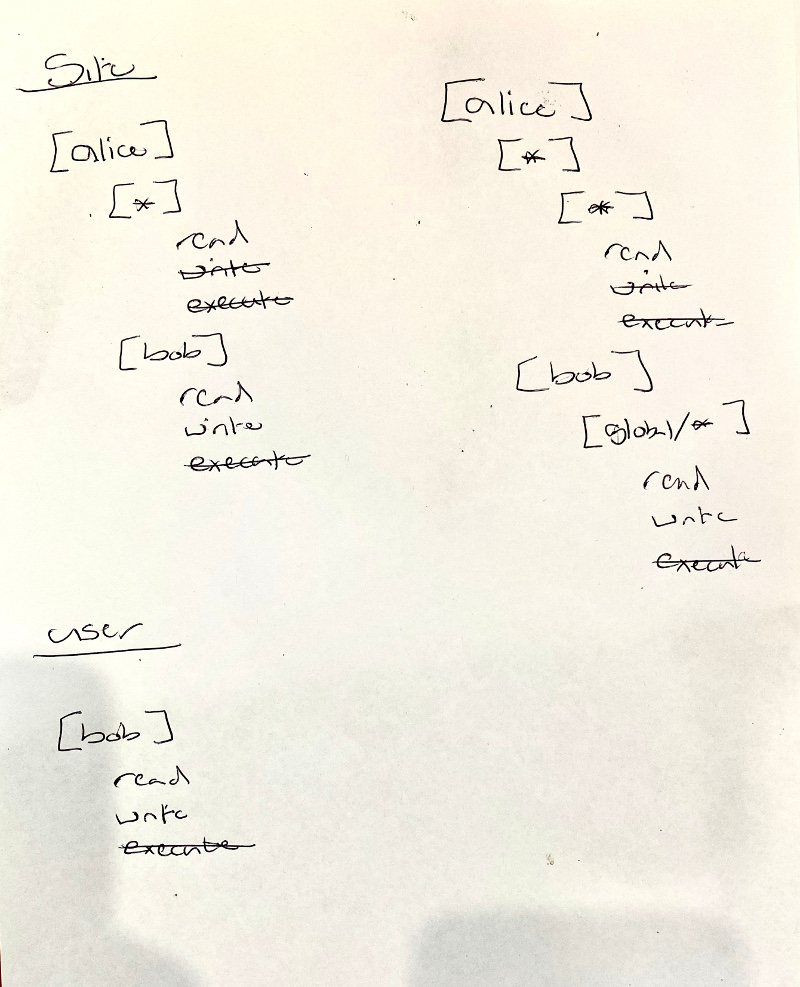
UIS Sub-services
- (OS) scan would be faster by parsing OS process listings
- (MH) Back-end Authentication
- Authorization method and config
- BOM C7 pen test report relevance to C8?
- consider and document BOM threat modeling points
Thursday
(carried forward from Wednesday)
- (JR) BOM would like to be able to start the UI in read-only or read-execute-only mode, and have a button to escalate to authorized level, possibly with force re-authentication at that point. Full privileges should time out after a configurable interval of inactivity (probably a full shift, because the UI is often used for no-interaction monitoring for long periods). (Belongs in Thursday’s security session). (Probably after Cylc 8)
Multi-user gscan
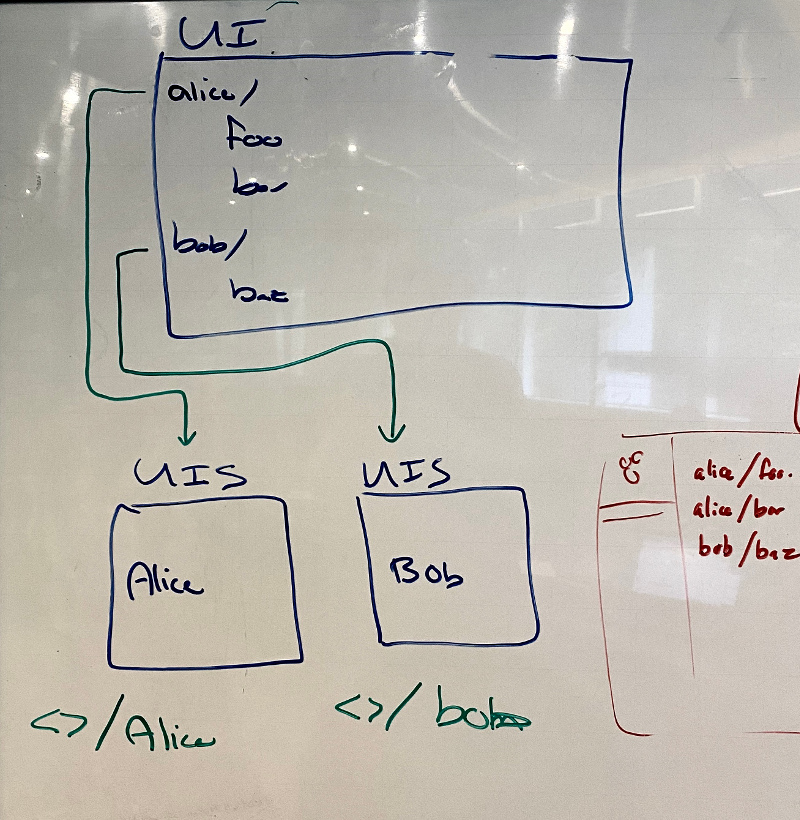
Security
- J-Hub “internal SSL” (between proxy and hub) is optional
- (SSL is really TLS now)
- DM couldn’t get it working
- (BK) the :8000 URL is the proxy
- TODO need to understand how all hub and proxy comms work
-
JR: BOM might want start in read-only (or read-execute) mode, and have to explicitly elevate to full authorized (e.g. read-execute-write) privileges (and maybe require re-authentication for that).
-
note we have only one end-point for mutations, at each component (small attack surface)
- UIS-WFS: CurveZMQ
- Hubless operation? don’t bother
- UI session timeouts?
- disconnect after 15 min, configurable to never? (for long monitoring)
- (Hub auth cookie expire forces re-auth)
- UIS could drop the session?
- TODO can J-Hub do this
- No tracebacks in production code (reveals internal paths etc.)
- to clients, that as (maybe to authorized clients?)
BOM Threat Modeling
- went through the list of points and addressed each one
BOM VC
- present: IB, DA, MN, TL, MW
- some discussion about aspects of architecture and secure connects
- follow-up:
- HO sent comprehensive email to BOM participants + DM and JR
- JR to document security of the architecture
Cylc 7 to 8 transition
- DM: restart from cylc 7 will not be supported
Friday
Versioning, packaging, and deployment
- conda seems the most straightforward for us to focus on now
- but still some issues to work through
- and keep an eye on containers etc. too, for the future
- conda meta-package will track cylc-flow version
- components may release minor versions between full releases
- node is not well liked by security people
- we only use it to build the UI
- could build the UI with node then package the build for pip
- configurable http proxy (J-Hub default proxy) is a node package though
- traffic proxy may be an option (written in Go)
- the central cylc wrapper script will still work for choosing between multiple installed versions
- UI should be upgradeable on the fly (like Riot)
- it is just a static dir
- use an arbitrary UI version parameter in the URL to avoid browser caching
- we can do incremental UI upgrades without full conda meta-package releases
- DM: main users of the conda metapackage will be individuals not sites
- UI dist size is not too bad now
- Deployment by Docker?
- should be usable just like a conda Cylc installation
- OK for the central wrapper
- only local background jobs different (they’ll run inside the container)
cylc hubshould be an entry point plugin supplied by the UIS package- just J-Hub under the hood, but needs to pick up our config file
- minimal install for job platforms: just CLI
- OS: we can have
scriptsas acylc-clisub-package insidecylc-flow(same repo, two pip packages, with one a superset of the other).
- OS: we can have
- CLI and version command can stay in cylc flow now
cylc versionreturns cylc-flow version- … unless installed by conda, then (TBD) we need another way to retrieve that version (cylc meta package adds another version)
Alpha-2 release
- via conda forge if possible
- BK and OS to follow up on any outstanding c-forge PR review questions
7.8.5 release?
- few closed issues, not worth releasing yet
UIS back compat?
- OK unless we increment the API version
- forward compat not possible
- spawn latest UIS version by default
- could force auto-shutdown-and-restart (on timeout?) … maybe not popular
UI datastore
- not yet handling deltas - but that is conceptually quite simple
- (OS) flat store is essential if possible
- views should construct the data structure they need as a skeleton populated with references to (not copies of!) the data store elements
- drop live file tailing for 8.0?
- text editor in UI easy enough (no need to reinvent that wheel)
Cylc Review
- TODO make old Cylc 7 version work with Cylc 8 workflows
- so it is easier to kill Cylc Review later (proper UI integration should render it obsolete)
CLI use of ZMQ or UIS needs to be configurable (no built-in fallback)
CLI - if interactive need ZMQ, else https will do
Documentation TODO
-
UI Guide (in the UI)
- Cylc 7-8 migration guide
- platforms
- “rose suite-run” migration changes - file install, cylc-run structure, etc.
- config changes
- no restarts from Cylc 7
- the new UI
- Python 2 to 3 for xtriggers etc.
- plugins (xtriggers etc.)
- Jinja2 (version number upped … meh)
-
User Guide - massive upgrade to reflect the new system
- Security Overview of the new architecture - cylc-doc#113.
- model on J-Hub docs
- JR to start on this
-
TODO - put the above in an issue on cylc-doc
- A better network diagram?
